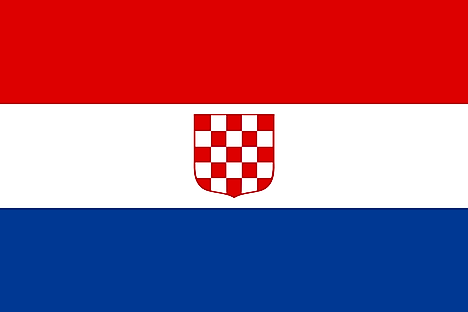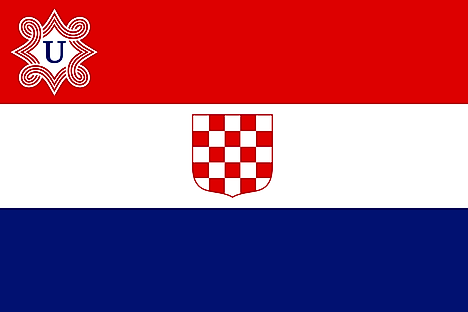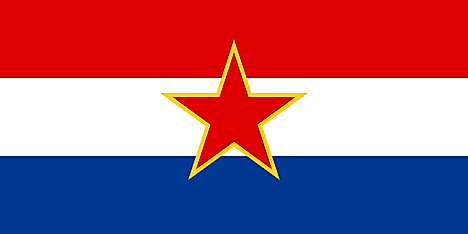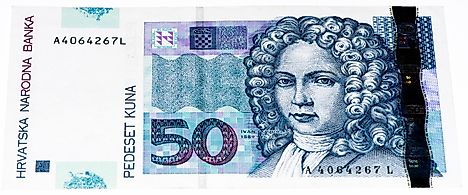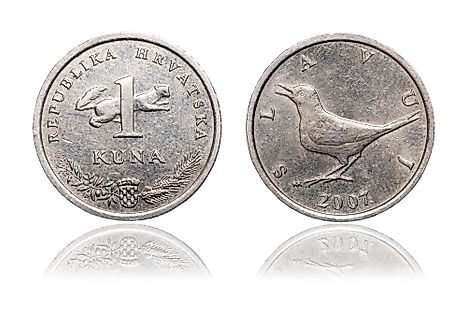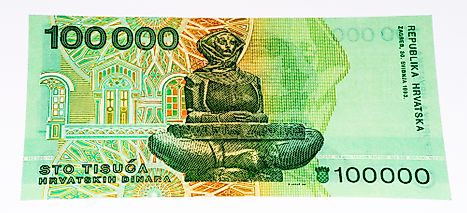Flags, Symbols, & Currencies of Croatia
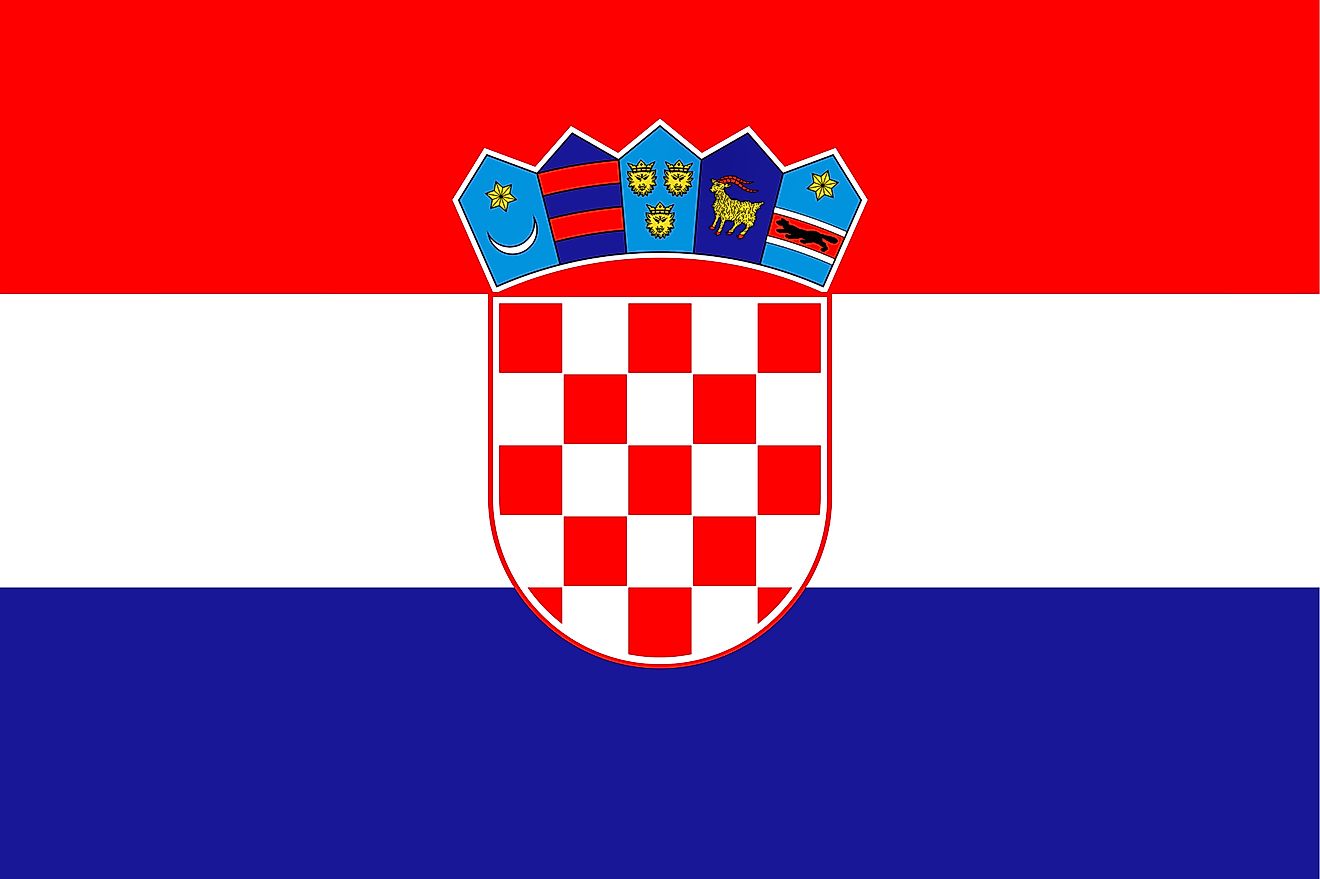
The national flag of Croatia is one of the country's national symbols. It was officially adopted on December 21, 1990, following the collapse of the Soviet Union. The flag consists of three equal horizontal bands of red (top), white, and blue - the Pan-Slav colors - superimposed by the Croatian coat of arms; the coat of arms consists of one main shield (a checkerboard of 13 red and 12 silver (white) fields) surmounted by five smaller shields that form a crown over the main shield; the five small shields represent five historic regions (from left to right): Croatia, Dubrovnik, Dalmatia, Istria, and Slavonia
The red, white and blue are traditional Croatian and pan-Slavic colors. The colors resemble those on the flag of Russia except that on the Russian flag, white appears at the top, followed by blue then red. Besides Russia and Croatia, several other countries also use the three colors on their flags, including Czech Republic, Slovekia, Serbia, Montenegro, and Slovenia.
History of the Flag of Croatia
The tricolor flag has been used in Croatia since 1848. The three colors (red, white, and blue) are a combination of the colors on the flag of the Kingdom of Slavonia (white and blue) and the Kingdom of Croatia (white and red). These two kingdoms and the Kingdom of Dalmatia formed the Croatian Kingdom's constituent states. When he Independent State of Croatia was established in 1941, a flag simolar to the modern one was adopted. However, the flag did not bear the shield but had the letter "U" at the top left corner. When Croatia joined the SFR Yugoslavia, the letter "U" was replaced with 5-pointed star with yellow border in plce of ths shield. In May 1990, the shiled replaced the star
Symbols of Croatia
National Coat of Arms of Croatia
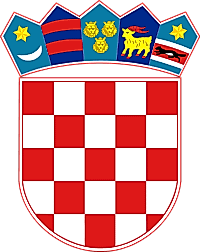
Croatia's coat of arms is a checkerboard shield, containing exactly 13 red and 12 silver squares. Above the shield rests five smaller shields, forming a crown over the shield. The five smaller shields are represent Croatia's five historical regions, including Croatia, Dubrovnik, Dalmatia, Istria and Slavonia (left to right).Coat of arms was first used during World War II. However, the red and white checkerboard was used as a symbol in the Kingdom of Croatia in 1495. The current Coat of Arms was adopted on December 21, 1990, alongside the national flag.
National Anthem
- Anthem Title: Lijepa naša domovino
- Music composer: Josip Runjanin
- Lyricist: Antun Mihanović
- Date of Adoption: 1941
Lijepa naša domovino is the national anthem of Croatia. Antun Mihanović wrote the original lyrics in 1835, publishing them under the title: Horvatska domovina (Croatian Homeland). In 1946, Josip Runjanin, composed the music under the title: Horvatsska domovina. The title: Lijepa nasa was adopted in 1861. However, it was not until 1941 that the song was adopted as Croatian national anthem
Lijepa naša domovino (Croatian)
Lijepa naša domovino,
Oj, junačka zemljo mila,
Stare slave djedovino,
Da bi vazda sretna bila!
Mila kano si nam slavna,
Mila si nam ti jedina,
Mila kuda si nam ravna,
Mila kuda si planina!
Teci, Dravo, Savo, teci,
Nit' ti, Dunav, silu gubi,
Sinje more, svijetu reci
Da svoj narod Hrvat ljubi
Dok mu njive sunce grije,
Dok mu hrašće bura vije,
Dok mu mrtve grobak krije,
Dok mu živo srce bije!
Our Beautiful Homeland
Our beautiful homeland,
Oh so fearless and gracious,
Our fathers' ancient glory,
May you be blessed forever.
Dear, you are our only glory,
Dear, you are our only one,
Dear, we love your plains,
Dear, we love your mountains.
Drava, Sava, keep on flowing,
Danube, do not lose your vigour,
Deep blue sea, tell the world,
That a Croat loves his homeland.
Whilst his fields are kissed by sunshine,
Whilst his oaks are whipped by wild winds,
Whilst his dear ones go to heaven,
Whilst his live heart beats.
The Currency of Croatia is the Croatian kuna
The official currency of Croatia is the kuna and has been used as the currency since 1994. Kuna is subdivided into 100 lipa and minted by the Croatian National Bank. The Croatian currency consists of coins and notes. The coins are in denominations of 1, 2, 5, and 25 kunas. The coins that were issued in odd years have the name of the plant or animal written in Croatian language while those minted in even years have the name in Latin. Generally, coins with Croatian names are more than those with Latin names. These coins are made of nickel silver and are milled. In the obverse side, they contain; coat of arms, state title, and indication of value. The year of minting is indicated in the reverse side.
The kuna notes on the other hand come in denominations of 5, 10, 20, 50, 100, 200, 500, and 1000. The 5 kuna note is the smallest in size measuring 122× 61 mm while the thousand measures 150×75 mm. All the notes except the 5-kuna note have geometric figures at the lower left on front for recognition by the visually impaired. The notes feature prominent Croatians at the front and architectural motifs at the back.
History of kuna
The use of kuna can be traced back to the year 1018 although it is not properly documented. At that time it is worth 1/25 Ukrainian hryvnia. However, the Croatian-Hungarian Kingdom led to diminishing of in the autonomy of Croatia and consequently gradual disappearance of the currency from circulation in the 14th Century. The currency reappeared in circulation in 1940 in Banovina which was an autonomous province within the Kingdom of Yugoslavia. The currency gained popularity when the independent State of Croatia was formed by the Ustase Kingdom. However, the currency disappeared again in 1945 when it was replaced by the Yugoslav dinar.
Modern kuna Currency
After disappearing in 1945, the modern kuna currency was reintroduced in 1994 with an exchange rate of 1 kuna= 1000 dinnars. However, the use of the name kuna was controversial with critics arguing that the same currency had been tried twice in vain. They proposed to use the name “kruna” which was also opposed since the same name was being used by Hungary. This was inappropriate since Croatia was a sovereign state. The use of the Croatian euro might be coming to an end when Croatia, which is a EU member, joins the European monetary system. The kuna will then be replaced by the Euro as a requirement of being a EU member.
Exchange Rates of the kuna
One USD will fetch you 6.49 kunas currently while a Euro exchanges at 7.41 kunas. A pound goes for 8.55 kunas and you will need 1.32 Japanese Yen to get a kuna. If converted to the south African Rand, a kuna will yield 2.02 Rands.
Historical Currencies of Croatia
Croatian dinar was the official currency of Croatia before it was replaced by kuna. Dinar was used between December 1991 and May 1994. It replace the Yugoslav dinar which was used during the SFA Yugoslavia. However, Croatian dinar was not meant to be a long-term currency. It was simply a transitional currency following the country's independence declaration. Dinar banknotes were in the denominations of 1, 5, 10, 25, 100, 500, 1,000, 2,000, 5,000, 10,000, 50,000, 100,000
